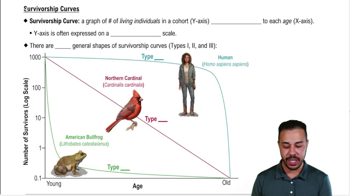Population Demography exam Flashcards
 Back
BackPopulation Demography exam
1/28
Terms in this set (28)
- DemographyThe statistical study of population characteristics, including size, structure, and distribution.
- What factors influence population characteristics in demography?Birth rates, death rates, and migration.
- Life TableA comprehensive statistical table that shows a population's survivorship, mortality, and reproductive rates of a cohort.
- CohortA group of same species individuals born into a population around the same time.
- Why do life tables often only include data on females?Because only females produce offspring, having a greater impact on population dynamics.
- Survivorship CurveA graphical representation of a life table, showing the number of living individuals in a cohort surviving to each age group.
- Type 1 Survivorship CurveCharacterized by low early mortality and high mortality later in life; example: humans.
- Type 2 Survivorship CurveCharacterized by a constant mortality rate throughout the species' lifetime; example: northern cardinal.
- Type 3 Survivorship CurveCharacterized by high early mortality and low mortality later in life; example: American bullfrog.
- What is the significance of a logarithmic scale in survivorship curves?It allows for a wide range of values to be plotted on the same graph.
- What does a life table's age interval represent?The specific age range being analyzed for survivorship and mortality rates.
- FecundityThe capacity for an organism to reproduce, often measured as the average number of female offspring per female.
- What does a survivorship curve's y-axis represent?The number of living individuals in a cohort.
- What does a survivorship curve's x-axis represent?The age groups of the cohort.
- Mortality RateThe overall death rate between age intervals in a life table.
- SurvivorshipThe proportion of organisms still alive at the start of an age interval.
- What is the purpose of a life table?To summarize demographic data for cohorts, focusing on survivorship, mortality, and reproductive rates.
- How is the mortality rate calculated in a life table?By dividing the number of deaths by the initial number of organisms in the age interval.
- What is the main focus of demography?Analyzing population dynamics and ecological interactions.
- What does a type 1 survivorship curve indicate about a species?Most individuals survive to adulthood, with high mortality rates later in life.
- What does a type 2 survivorship curve indicate about a species?Mortality rates are constant throughout the species' lifetime.
- What does a type 3 survivorship curve indicate about a species?High mortality rates early in life, with few individuals reaching adulthood.
- Why is understanding survivorship curves important?They help in analyzing population dynamics and predicting future population trends.
- What is the relationship between life tables and survivorship curves?Survivorship curves are graphical representations of the data in life tables.
- What is the significance of the age interval in a life table?It helps in analyzing the survivorship and mortality rates at different stages of life.
- How is survivorship calculated in a life table?By dividing the number of organisms alive at the start of an age interval by the initial number of organisms.
- What is the importance of studying demography?It provides insights into population trends and helps in making informed decisions for conservation and management.
- What does the term 'population dynamics' refer to?The changes in population size, structure, and distribution over time.



